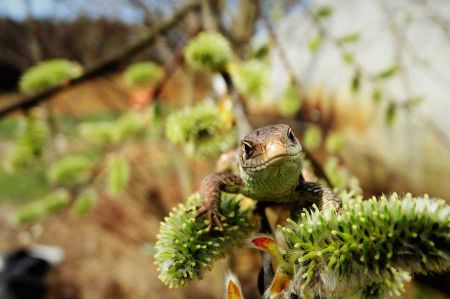The sand lizard uses the first rays of the sun
- Written by Portal Editor
Wonderful days with lots of sunshine once more lured us out into the forest, which must have felt a lizard in a similar way. The lizard needs solar energy to get its body temperature going, because like all reptiles they are cold-blooded.
This means that lizards cannot regulate their body temperature on their own. They need the sun to warm their bodies up. This is why it is easiest to observe them on rocks or large stones that have been warmed by the sun. Because of our predominantly cool weather, there are only a few lizard species in Germany - it is simply too cold for them here! Which is very similar to many of us.
Sand lizards are still quite common here
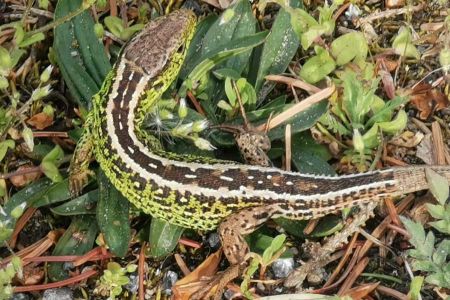 Unfortunately, as already mentioned before, there are only five species of lizards native to Germany; they belong to the group of reptiles. Lizards have a rather elongated physical body shape, which is often reminiscent to that of snakes. However, they have four legs that allow them to run very quickly. Their skin shows a scale-like structure that is shed from time to time, called the peeling. A new layer of skin has already formed underneath. The most colorful of them, the green lizard, only occurs in some warm regions in southern Germany and in Brandenburg. Incidentally, it is our second longest lizard after the slow worm. Four other species are native to us too: the wall lizard, the sand lizard, the forest lizard and the Croatian mountain lizard.
Unfortunately, as already mentioned before, there are only five species of lizards native to Germany; they belong to the group of reptiles. Lizards have a rather elongated physical body shape, which is often reminiscent to that of snakes. However, they have four legs that allow them to run very quickly. Their skin shows a scale-like structure that is shed from time to time, called the peeling. A new layer of skin has already formed underneath. The most colorful of them, the green lizard, only occurs in some warm regions in southern Germany and in Brandenburg. Incidentally, it is our second longest lizard after the slow worm. Four other species are native to us too: the wall lizard, the sand lizard, the forest lizard and the Croatian mountain lizard.
Hunter and prey at the same time - sand lizards
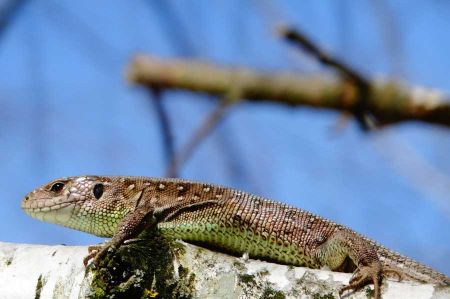 Most species are small, slender, agile, ground-dwelling animals. The total length ranges from 12 to 90 cm, with smaller shapes also predominating. Four five-toed limbs are always well developed, as is a very long tail. Unlike other lizards, there are no sticky toes, throat pouches or back combs. The top of the head has symmetrical shields.
Most species are small, slender, agile, ground-dwelling animals. The total length ranges from 12 to 90 cm, with smaller shapes also predominating. Four five-toed limbs are always well developed, as is a very long tail. Unlike other lizards, there are no sticky toes, throat pouches or back combs. The top of the head has symmetrical shields.
Lizards feed on small invertebrates such as insects, spiders, and earthworms. Some species like the wall lizard also eat their own conspecifics. Lizards themselves have to be particularly careful of snakes and birds. But if a predator grabs the lizard by the tail, the tail can be thrown off at predetermined breaking points (autotomy) and regenerated later, a new stub grows back later.
Body and reproduction of the lizards
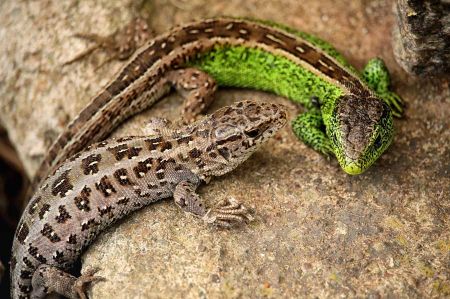 Not all lizards breed equally. Most lay three to twenty eggs at a time. Just the wall lizard can lay eggs up to three times a year. The forest lizard, however, keeps its eggs in its belly until the young have hatched. Then they are born.
Not all lizards breed equally. Most lay three to twenty eggs at a time. Just the wall lizard can lay eggs up to three times a year. The forest lizard, however, keeps its eggs in its belly until the young have hatched. Then they are born.
A zygomatic arch is present, but the temple opening is covered by skin bones that have grown together with the skull bones. The dentition is pleurodont, i.e. the teeth sit without roots on the inner edge of the jaw, they are attached to the side of the inner edge of the jaw on a longitudinal ridge and fixed with a ring band. The lateral teeth often have two to four cusps. The eyelids are usually freely movable and the pupils are round. The outside of the eardrums is clearly recognizable. The throat is almost always separated from the breast scales by a scaled cross band, the so-called collar. The ventral scales, which are usually arranged in regular longitudinal and transverse rows, are larger than the back scales. Glandular scales (thigh pores) on the underside of the thighs are usually present; from these the males secrete a waxy mass at the mating season.
Often there is sexual dimorphism in that the males are more vividly colored than the more inconspicuous females. Almost all species lay eggs (oviparous), only some are viviparous (including the forest lizard), and a few reproduce parthenogenetically.
Species diversity and habitat - human-made restrictions
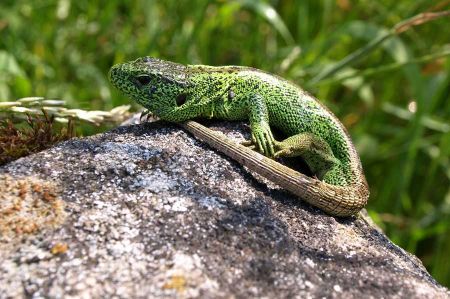 There are currently around 350 species in more than 40 genera. The system of genera and species is based on the online database "Reptile Database".
There are currently around 350 species in more than 40 genera. The system of genera and species is based on the online database "Reptile Database".
Real lizards are found in Europe, Africa and from Middle East to Southeast Asia. They did not reach Australia and they cannot be found on either of the two American continents. There are five species in Germany and Switzerland, the sand lizard (Lacerta agilis), the western (L. bilineata) and eastern green lizard (L. viridis), the wall lizard (Podarcis muralis) and the forest lizard (Zootoca vivipara). The Croatian mountain lizard (Iberolacerta horvathi) is also found in southern Austria.
In northern Europe, the sand lizards are the most common lizards in nature. They are most likely to be endangered because humans rob them of their habitats: the dry stone walls in the vineyards, for example, used to be built without mortar in the past. That gave a lot of living space, especially for the wall lizard.
Please read as well:
Along the Unstrut river - Pollard willows by the wayside
Gdansk - recreational & nature reserves line the bike paths
